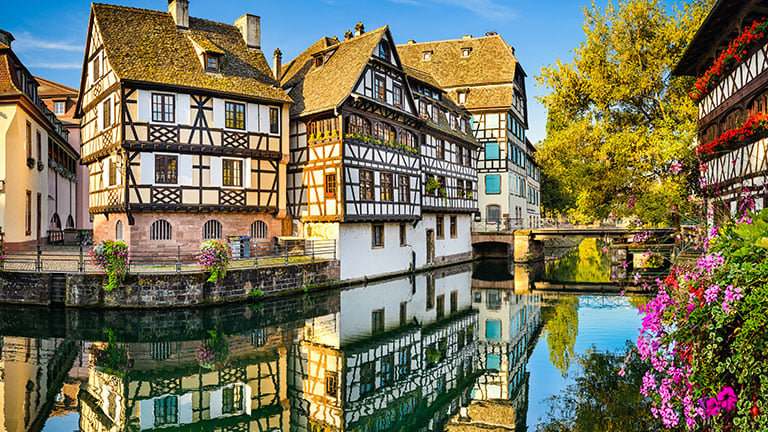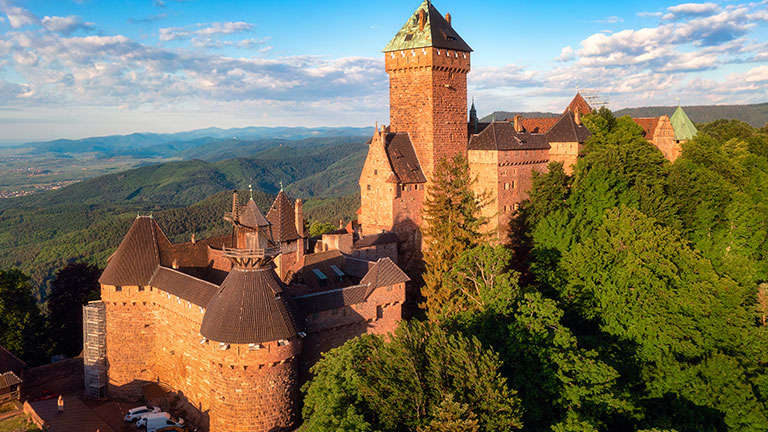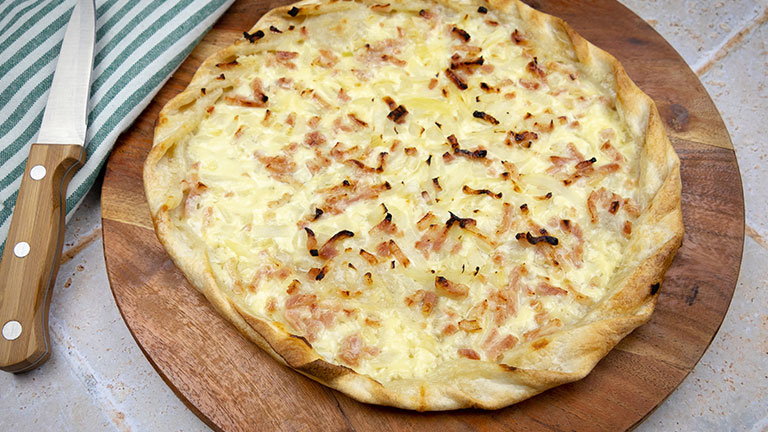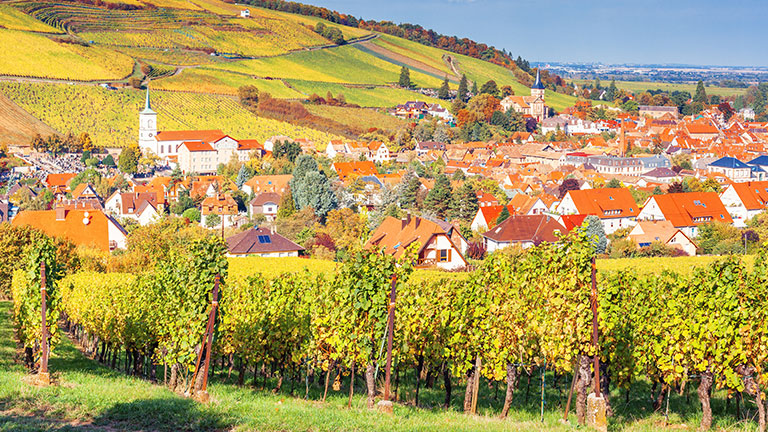Why Alsace, France, Should Be on Your Bucket List
Fairy-tale villages and cross-cultural cuisine make for a magical vacation in this northeastern region of France sprinkled with German influences

It was a mild summer evening as my husband and I sipped riesling in a walled garden behind our rental house in the French village of Boersch. A calico cat, who came with the house, wound and curled between our legs, purring gently.
I was contemplating how much I preferred this storybook setting to the cacophony of Paris, from which my husband, teenage daughter and I had departed by train the previous morning. We had headed to Alsace, a picturesque region in northeastern France bordered by Germany on the east and Switzerland to the south. Renowned for its blend of French and German influences, Alsace is a fairy tale come to life with villages of turreted and half-timbered houses, flowerboxes above cobblestone streets, medieval castles on hilltops, and cuisine and wines distinct from those in the rest of France.
A kingdom of castles
Boersch, our headquarters for the week, was everything I imagined an Alsatian village to be: centuries-old buildings in muted hues, with kelly-green and burnt-orange shutters and window boxes trailing vines. Refreshingly sleepy, Boersch has a single grocery store, one bottle shop and a restaurant (open only a few hours a day). Protected by three 14th-century gates, the village, like so many in Alsace, once required fortifications to protect itself from frequent raids, not to mention
the more recent conflicts of this oft-disputed borderland between France and Germany. More than 80 medieval fortresses like this occupy the Vosges Mountains and Alsace Plain, some nearly in ruins, others standing as majestically as they did centuries ago.
Among the latter is the Château du Haut-Koenigsbourg, about a 45-minute drive south of Boersch. We made this restored castle the centerpiece of a day trip. Built in the 12th century and standing as part of a long defensive line at the edge of the Holy Roman Empire, the pink sandstone castle looms large over the Alsace Plain with views of Germany’s Black Forest and the Swiss Alps.
After its 17th-century sacking, the château stood abandoned for two centuries,
becoming one with the forest until Kaiser Wilhelm II gained control of Alsace after
the Franco-Prussian War (1870 to 1871). The kaiser had the castle fully restored to something beyond its former glory and hosted foreign dignitaries there. His touch is still evident in the opulence of the castle’s public rooms, decorated with stained glass, frescoed ceilings and tiled pôeles (stoves). My daughter and I admired the heavy iron doors, spiral staircases and infinite interior well.

Alsatian castles were only the beginning, however. Even more appealing were the region’s idyllic cities and villages, including Strasbourg, a jumble of glassy-surfaced canals, turreted buildings and stone-paved streets.
Its main quarter, or La Petite France, is a UNESCO World Heritage Site and consists of the Grande-Île, the city’s historic original center, and the Neustadt, or “new town.” Both areas radiate from the city cathedral into a landscape organized around the River Ill and its canals. As a lover of architecture, I appreciated Strasbourg’s variety of structures reflecting Roman Antiquity, the Middle Ages, the Rhineland Renaissance and 18th-century French classicism.
At the time of our visit, Strasbourg sported banners in support of Ukraine. No doubt Alsatians feel empathy with the Ukrainians, given that both occupy historically disputed borderlands. Between 1871 and 1945, Alsace switched hands four times, with France sacrificing the region to Prussian/German ambitions following both the Franco–Prussian War and at the outset of World War II, when more than 100,000 Alsatian men were forcibly drafted into the German Army.
We spent much of the day strolling Strasbourg’s historic quarter, known for its covered bridges and defense towers that once formed part of the city’s fortifications. Among our stopping points was the Church of Old Saint Peters, which houses both Catholic and Lutheran congregations, reflective of Alsace’s French and German influences. As we gazed up at the vaulted ceilings and stained-glass windows of the Gothic structure, with perfect timing, an organist began playing ethereal music.
We capped off our day in Strasbourg at one of the city’s many winstubs (taverns) and ordered tarte flambée, a thin, crispy flatbread topped with crème fraîche, onions and bacon. This staple dish originated as a way for farmers to test the heat of their wood-fired ovens before baking bread.

The next day, we explored some smaller villages, including the medieval town of Rosheim, where well-preserved houses and cobblestone streets made for a perfect wander. There, we visited two 12th-century Romanesque buildings, the Saint-Pierre-et-Saint-Paul Church and the so-called Pagan House, one of the oldest stone houses in Alsace.
Before we departed the village, we stopped into Boulangerie Rohmer, which lays claim to being France’s oldest bakery, to purchase some supplies for later: peasant bread and Munster-Géromé cheese, decadent chocolate and cream pastries, and the house specialty ropfkueche, a brioche dough-based pie of butter, sugar,
cinnamon and nuts.
Next, we headed south to the village of Barr, characterized by a delightful smattering of quaint cafés patronized by locals. We grabbed lunch at the Restaurant Maison Rouge Barr, sampling schnitzel with a side of Alsatian choucroute (sauerkraut cooked in wine). There’s not much English spoken in these smaller villages, and it’s rare to find English on the café menus, so my high school French came in handy.

Five centuries of winemaking
Barr is part of the 105-mile Route des Vins d’Alsace and is surrounded by vineyards, which pleased me as a lover of French wines. The nearby Vosges Mountains protect the area from too much rainfall, allowing grapes to ripen fully while retaining acidity, and a varied soil composition contributes to the complexity and minerality of its wines.
In a region with more than 1,000 wineries, you could easily make an entire vacation
out of tasting. We did our best to sample the local viticulture, visiting a few wineries. First up was Achillée, housed in France’s largest straw-bale-constructed building. This fully organic winery features earthy-flavored wines produced using natural yeasts and no pesticides. We tried several of the natural wines, including bright effervescents and some earthier versions of gerwürtztraminer and pinot noir.
Our next stop was the tasting room of Rolly Gassman overlooking the picturesque village of Rorschwihr. Walls of windows with expansive views of rooftops and lush green hills mingled with displays of rocks and fossils collected from the surrounding estate. My husband and I settled in for a marathon wine tasting, while my daughter sketched by the windows. The Gassman family has been crafting Alsatian wines since 1611, and it shows in the options available, from almost exclusively German varietals like sylvaner to the white grape version of pinot noir known as pinot blanc.
While Alsatian wines are mostly whites—including riesling, gewürztraminer, pinot gris and muscat—winemakers here also produce an orange-red pinot noir that’s as smooth as silk. Longtime lovers of French reds, my husband and I savored nearly a dozen varietals of both reds and whites and listened intently to descriptions from our wine steward of the type of soil from which each one grew.
Back in Boersch that evening, we indulged in a bottle of Pinot Noir de Rodern, sipping it in the enclosed garden behind our cozy cottage in the quietest of Alsatian villages. Meanwhile, our borrowed calico cat skittered down the garden walls to join us for our final night nestled in the perfect tranquility of what had become for our family a welcome respite in the rolling, castle-topped hills of Alsace.
